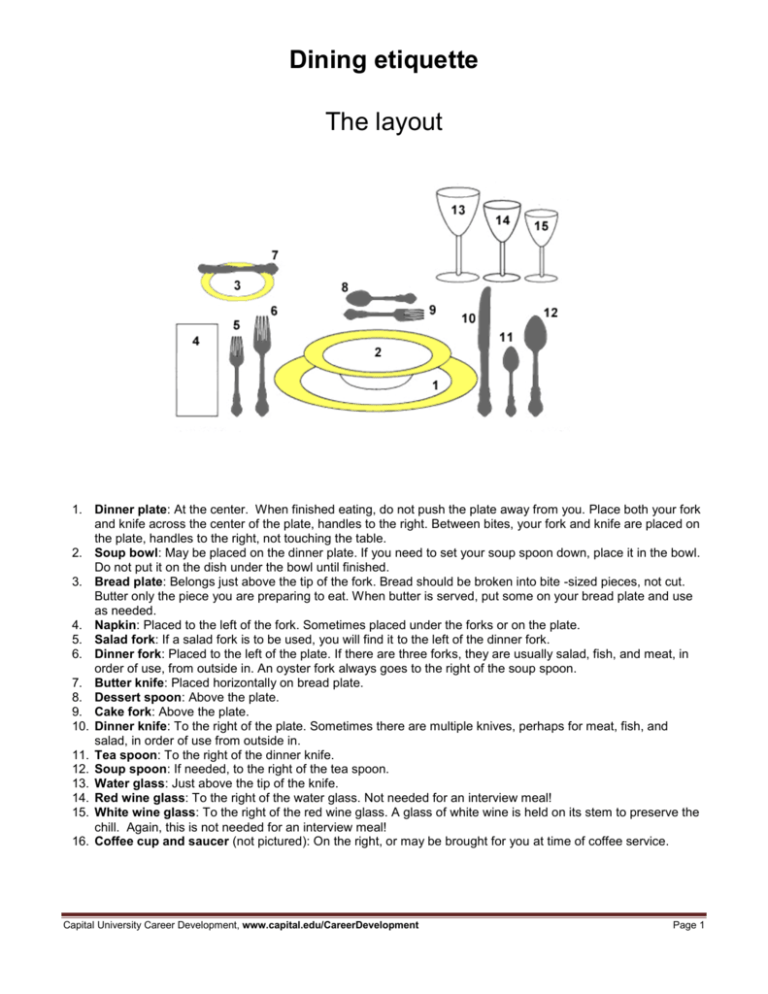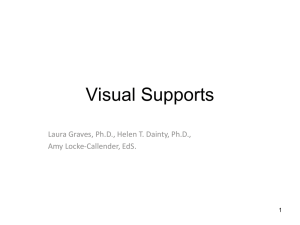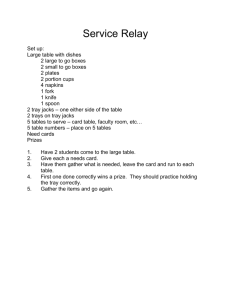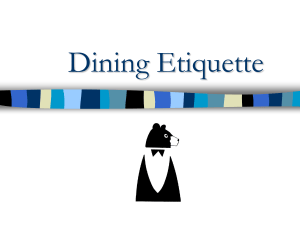Dining etiquette Q & A from Virginia Tech Career Services
advertisement

Dining etiquette The layout 1. Dinner plate: At the center. When finished eating, do not push the plate away from you. Place both your fork and knife across the center of the plate, handles to the right. Between bites, your fork and knife are placed on the plate, handles to the right, not touching the table. 2. Soup bowl: May be placed on the dinner plate. If you need to set your soup spoon down, place it in the bowl. Do not put it on the dish under the bowl until finished. 3. Bread plate: Belongs just above the tip of the fork. Bread should be broken into bite -sized pieces, not cut. Butter only the piece you are preparing to eat. When butter is served, put some on your bread plate and use as needed. 4. Napkin: Placed to the left of the fork. Sometimes placed under the forks or on the plate. 5. Salad fork: If a salad fork is to be used, you will find it to the left of the dinner fork. 6. Dinner fork: Placed to the left of the plate. If there are three forks, they are usually salad, fish, and meat, in order of use, from outside in. An oyster fork always goes to the right of the soup spoon. 7. Butter knife: Placed horizontally on bread plate. 8. Dessert spoon: Above the plate. 9. Cake fork: Above the plate. 10. Dinner knife: To the right of the plate. Sometimes there are multiple knives, perhaps for meat, fish, and salad, in order of use from outside in. 11. Tea spoon: To the right of the dinner knife. 12. Soup spoon: If needed, to the right of the tea spoon. 13. Water glass: Just above the tip of the knife. 14. Red wine glass: To the right of the water glass. Not needed for an interview meal! 15. White wine glass: To the right of the red wine glass. A glass of white wine is held on its stem to preserve the chill. Again, this is not needed for an interview meal! 16. Coffee cup and saucer (not pictured): On the right, or may be brought for you at time of coffee service. Capital University Career Development, www.capital.edu/CareerDevelopment Page 1 Rules for an interview over a meal GENERAL INFORMATION Remember the purpose of the meal. Especially when your meal is a part of an interview, it is important to remember your reason for being there. Focus on making a good impression, getting to know your interviewers, and answering questions. Don’t focus on “getting full”, or on the quality of the food. It’s all about the interview. Q: Why are lunch and dinner interviews important? A: Employers may want to see you in a more social situation to see how you conduct yourself, particularly if the job for which you are interviewing requires a certain standard of conduct with clients and superiors. You could be critically scrutinized on your table manners and conduct. On a practical level, interviews that last for several hours may extend through mealtimes, and the employer is acting as a gracious host to provide you with meals. The meal is a time to visit and interact, and this is always more important than the function of eating. Q: How do I eat and answer questions at the same time? A: By taking very small bites, so you can quickly finish and swallow the bite before speaking. Never speak with food in your mouth. You may not have much time to eat if you are being asked a lot of questions; remember that the main point of the meal is to interact; eating is secondary. You can ask questions, too, so that the conversation is more balanced and you have time to eat. Don't eat too quickly, and don't try to hurriedly scarf down all your food. AS YOU SIT DOWN Q: Who should sit down first? A: You should wait for your interviewer/host to ask you to sit down before taking your seat. If he/she doesn't ask you to sit, wait for him/her to be seated, then sit. Q: What do I do with my napkin? A: As soon as everyone is seated, unfold your napkin and place it across your lap, folded, with the fold toward you. Do this discreetly without flourish. In an interview situation, you might want to follow your host’s lead. Q: Is it okay to sit with my legs crossed? A: During the meal, sit up straight and keep your feet flat on the floor, or women can cross their ankles. Crossing your legs during the meal can cause you to slouch, and looks too casual. Q: When is it okay to begin drinking and eating? Should one wait until the host/hostess starts eating his/her meal at a restaurant? A: If water is on the table as you are seated, it is appropriate to sip your water after everyone is seated and after you have placed your napkin in your lap. For other beverages and foods, wait until everyone has been served, and do not eat until your host/hostess has begun; when your host picks up his/her fork, this is an indicator that you may do so. Don’t help yourself to bread and other communal foods until your host has indicated you may do so. THE LAYOUT Q: Which salad plate, bread and butter plate, and drinks are mine? A: Your salad plate and bread and butter plate are on your left, above your fork. Your beverages are on the right above your spoon. Remember that solids are on the left, and liquids are on the right. Q: Which utensil is for what? A: Always use your silverware from the outside in. So if you have two forks, the outside fork is for salad and the fork closest to the plate is for your main course (if you have a third, it’s for appetizers). The soupspoon is on your outermost right, followed by your beverage spoon, salad knife and dinner knife. Usually no more than three utensils are placed on each side of the place setting. If a fourth utensil is needed, it is placed above the plate and is usually for dessert and/or for coffee with dessert. The silverware will be removed as you finish each course. After you use a piece of silverware, never place it back on the table. Any unused silverware is simply left on the table. Capital University Career Development, www.capital.edu/CareerDevelopment Page 2 BEVERAGES Q: What should I order to drink? A: Water, juice, and iced tea are safe choices. It is best not to order alcohol even if the interviewer does. Coffee or hot tea after the meal is okay if this is offered and if time allows. Q: Is it rude or wrong to use multiple packets of sugar/sweetener in tea or coffee? A: Limit yourself to one or two packets of sugar. Using more than two packets of sugar or artificial sweetener may be seen as excessive. To use packets, tear one or both at the same time ¾ of the way at the top of the packet, and leave the paper waste at the side of the plate. BREADS Q: How should I pass things like the bread basket, butter and salad dressings? A: When your host indicates ("Please help yourself to bread," or something similar), the person closest takes the service plate/basket. If you pick up the bread basket, hold it while you offer some to the person to your left, then serve yourself, and then pass the basket to the person on your right. (Same applies to butter, salad dressings, and other condiments that are passed.) Always include the service plate in passing; don't (for example) lift the salad dressing bowl off the service plate and pass the bowl by itself. Foods should go from the service plate to your plate, never to your mouth. Butter should be placed on your bread and butter plate, not directly on your bread. Don't touch other people's food, and never use your used utensils to obtain food from a service plate. Q: Is it okay to spread butter on my entire roll at one time? A: No. Break off a bite-sized piece of your roll, butter it and eat it, one bite at a time. If the piece you break off is slightly too big to make one bite, it's fine to eat it in two bites. ORDERING FOOD In general, the employer will suggest that your order be taken first (his or her order will be taken last). Sometimes, however, the server will decide how the ordering will proceed (women's orders are often taken before men's). Q: What is appropriate to order for dinner? A: Choose simple foods that are easily eaten with a fork and knife (meats, simple salads and soups). Avoid spaghetti or other things with red sauce, huge deli sandwiches, greasy hand held items like pizza, and gassy foods like beans, broccoli, or cauliflower. As a guest, you should not order one of the most expensive items on the menu or more than two courses unless your host indicates that it is all right. If the host says, "The lobster is the specialty here; I think you'd enjoy it," or "I'm going to try this delicious sounding cheesecake; why don't you try dessert too?", then it’s all right to order that item if you would like. Sometimes you may not have a choice. Follow your host's lead. Q: What if the menu is “fixed” and I am served something I don’t want? A: Be polite and appreciative. Never criticize or state a dislike for a food that is served to you (something we all should have learned by now). This is insulting to your host. Simply eat foods you do like, and make an attempt to taste unfamiliar foods. If you are asked point blank if you like something, and it would be an obvious untruth to say you do, say something gracious like, "This is new for me; I'm glad for the opportunity to try this." The job for which you are interviewing may involve business travel and dining in other cultures than your own. You could be evaluated for you grace in such situations. Q: What is an appropriate way to explain a food allergy? A: If you know the menu in advance, you can let your host know ahead of time that you cannot eat a certain food. Be pleasant about your request, and apologize for any inconvenience. This allows your host to make arrangements for you. If food you cannot eat is served to you at a meal, simply leave it. Be discreet and pleasant if you are asked why you are not eating. In a restaurant where you are ordering from the menu, you can explain any allergies discreetly to your server. Again, be pleasant and don't call attention to yourself or make this a topic of conversation. Q: Is it best to avoid ordering a food if I can't pronounce its name? A: No. If you'd like it, ask the server to describe the food, and point to it on the menu. Capital University Career Development, www.capital.edu/CareerDevelopment Page 3 SOUP and SALAD Q: How should soup be consumed? A: Dip your spoon away from yourself to fill your spoon with soup. Rest your spoon periodically. When a service plate under the soup bowl is provided, always place your spoon on the service plate behind the bowl. If no service plate is provided, obviously you rest your spoon in the soup bowl. Never place a used utensil on the table. Sip quietly. To finish the last bit of soup, you may slightly tip your bowl (away) to fill your spoon. If plates are being cleared and you are not finished, simply lift your utensil as though you are in the process of eating. Q: Is it okay to cut my salad if the lettuce pieces are too large? A: Yes. Cut a few bites at a time; don't slice and dice the entire salad at once. It is preferable to cut large salad pieces than to attempt to stuff large bites of food in your mouth. THE MEAL Q: Is there a correct way to use the fork and knife? A: There are two main ways to use a fork and knife to cut and eat your food. Either style is considered appropriate. American style: Cut, then set the knife down and switch the fork to the other hand before eating The European or Continental style: Cut, then keep the fork in the same hand for eating Q: Where do I place the knife when I am eating? A: Put the knife across the top of your plate when you are not using it, blade facing toward you. Q: Do I follow the lead of my host even if he or she uses the wrong utensil? A: If you realize that someone is eating “incorrectly”, continue to eat properly, but obviously never point out errors. Q: How do I wipe my mouth with the napkin? A: The purpose of the napkins is to keep food off your face. Use it frequently to discreetly dap or wipe your mouth. Replace the napkin on your lap loosely folded, not wadded. Q: Should I go out of my way to use utensils when I am eating finger food? A: When in doubt, eat with a utensil rather than with your fingers, even those foods (like french fries) that you may eat by hand at home. If something is served on a plate, you should use utensils! Chicken, or any other meat with a bone, is not finger food; you should use the knife and fork. Q: Should I always pass the salt with the pepper, even if someone asks for salt only? A: Yes, always pass the salt and the pepper together. It is also considered rude to use it first before passing it to the person who asked for it. Q: Is it rude to season my food before tasting it? A: Yes. You should not salt and pepper your food before tasting it. Interviewers might assume from this behavior that you more generally take action without checking relevant information first. Also, it’s an insult to the chef. Try a bite first, then season if necessary. Don't “over season”. Q: Is it acceptable to use eye drops at the table? A: No grooming of any kind should be done at the table. You should excuse yourself for this purpose. Q: What is the appropriate way to excuse myself from the table? A: You can excuse yourself from the table by saying, "Excuse me"; do not feel the need to offer an explanation. If you must leave during the meal, place your napkin on your chair as a signal to your server that you will be returning. Q: Is it ever okay to remove my jacket for heat or other reasons? A: As a general rule, follow the lead of the host before removing your jacket. If the host keeps on his/her jacket, keep yours on. Keep in mind that some restaurants/clubs require customers to keep their jackets on during meals. Q: How do I call the server if I need him/her? A: You can usually catch her/his eye, but if not, you may ask a nearby server. If the matter is not urgent, wait until the server checks at the table to make sure everything is okay. Avoid getting up from the table to hunt someone down. Remember, the meal is not the main purpose for your being there. Q: Is it okay to rest my wrists on the edge of the table in between bites? A: Yes, it is all right to rest your wrists or forearms on the edge of the table or place your hands in your lap, but no elbows on the table! Capital University Career Development, www.capital.edu/CareerDevelopment Page 4 Q: As a left-hander, is there anything I should do differently? A: If you are allowed to choose your seat, choose a seat where you do not hit any other person's elbows. Q: Should I clean my plate in any particular way? A: You do not have to clean your plate. It is polite to leave some food on your plate. Do not push the remaining food around on the plate (obviously?). DESSERT Q: How do I eat dessert? A: It depends. Some dessert will come with its own utensils. If not, your utensils will either be closest to the plate (you should have used all the other utensils by now), or they will be placed at the top edge of the plate. END OF THE MEAL The host will usually signal the end of the meal by placing his or her napkin on the table. Q: How do I signal I am finished with my meal? A: Your silverware should be parallel to each other in the ten and four o'clock position (as on the face of a clock), with handles at 4:00 and tops of the utensils at 10:00. The knife blade points toward you. Never place or rest used utensils on the table. When the meal is over, you should also place your napkin neatly on the table to the right of your dinner plate. (Do not refold your napkin, but don't wad it up, either.) Leave your plate where it is when you have finished eating. Q: What do I do when the check comes? A: Typically in an interview, you are the guest and so the meal is paid for by the employer. Your host will most likely pick up the check so you won't have to deal with it. Remember to thank your host for the meal at its conclusion. PROBLEMS Q: What if I am served the wrong food, or it is not prepared the way I ordered it? A: If it's a major mistake, you can discreetly mention this to the server immediately so that it can be corrected. If the error is small — you didn't want tomatoes, but they are served to you, or you received the wrong side dish — ignore it. Fussing over food can make you look childish, finicky and concerned with the wrong things (not assets in a job candidate). Your goal is to appear gracious. Q: What if I drop my napkin on the floor? A: If your napkin falls on the floor and it is within easy reach, retrieve it. If you are unable to retrieve the napkin without drawing attention to yourself, ask the server for another one. Q: What if my dinner fork falls on the floor and I cannot get the server's attention? A: Never pick up dropped utensils. Wait until you get the server's attention and discreetly ask for a new utensil. Q: What if there is a hair (or something else) in the food? A: You have a few choices if you find hair in the food. You can discreetly remove it, eat around it, or politely ask the server to bring you another plate. In any case, don’t cause a scene and don’t spoil the appetites of others. Q: If I am a slow eater, should I finish my meal or indicate that I am done when everyone else is finished? A: In general, you should finish at about the time everyone else is finished. Try to stay with the pace of the meal so that you don't hold up the remaining courses, especially if this is an interview meal. Q: What if a piece of food falls off my plate? A: If the food falls on the floor, leave it and don't step on it. If the food falls on the table and it is a big piece, use your fork and move it to a corner of your plate. Otherwise, let it be. Q: How do I let someone know he/she has something in his/her teeth? A: You don’t. It will embarrass them, so forget about it, and try not to look at their teeth. Q: What if I get something stuck in my teeth? A: Try to discretely remove the lodged item with your tongue. If this does not work, excuse yourself from the table and go to the restroom. You might want to go to the restroom after the meal specifically to check your teeth before the interview continues. Toothpicks should be used discreetly and in private; never at the table. Capital University Career Development, www.capital.edu/CareerDevelopment Page 5 Q: What do I do when I don't want to swallow something I already have in my mouth (such as an olive pit, a bone, or a piece of gristle)? A: If it went in with your fork, it should come out with your fork (and likewise with your spoon or hands). Remove it unobtrusively with your fork and deposit it on the rim of your plate. No one should notice you doing this, because the fork to mouth motion is a common one made by anyone who is eating. Q: How do I avoid eating a certain food? (For example, onions on a salad) A: Discreetly eat around the food and/or move it carefully to the side of the plate or bowl. Don't make a fuss, and don't remove it from the plate. Q: What should I do if I feel sick during the dinner? A: If you really cannot make it through the dinner, just excuse yourself and go to the rest room. Return when you are feeling better or ask the server to explain that you are not feeling well. Q: What should I do if my food is cold or doesn't taste good? A: If your food needs to be warmer but is not unbearable, you should just eat it and not call the server over. However, if it is not edible, politely call the server over and explain. Q: What do I say when I really don't like my meal and someone asks, "How is your meal?" A: Be polite and say, "Fine, thank you." Don’t go overboard with false praise; it could get you into trouble. Questions? Contact Career Development (Eric Anderson or Jan Rich) Blackmore Library, Second Floor (West End) Email: CareerDevelopment@capital.edu Phone: 236-6606 Web site: www.capital.edu/CareerDevelopment Capital University Career Development, www.capital.edu/CareerDevelopment Page 6




